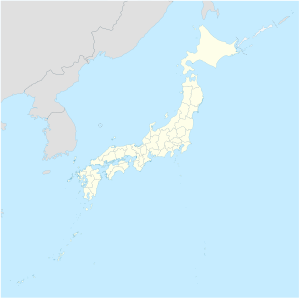Suribachi
| Suribachi | ||
|---|---|---|
|
Suribachi, photographed towards the north, 2001 |
||
| height | 170 m TP | |
| location | Iwojima , Tokyo Prefecture , Japan | |
| Notch height | 170 m | |
| Coordinates | 24 ° 45 '2 " N , 141 ° 17' 21" E | |
|
|
||
| Type | Cinder cone | |
| Age of the rock | 3,000 years | |
| Last eruption | May 2, 2012 | |
| Normal way | Mountain tour | |
| particularities | Raising the Flag on Iwo Jima during the Battle of Iwo Jima | |
The Suribachi ( Japanese 摺 鉢 山 , -yama ; English also Mount Suribachi ), also Paipu-yama ( パ イ プ 山 , "pipe mountain"), is a 170 m high mountain ( cinder cone ) on the island of Iwojima in the northwest Pacific and is the highest Place of the island. The well-known photo Raising the Flag on Iwo Jima was taken at the top of the mountain.
geology
The suribachi is active with fumaroles . There were minor outbreaks in 1982, 1994, 1999, 2004, 2009 and 2012; these were often phreatic explosions . In September 2001 a submarine eruption occurred about 150 to 200 meters off the southeast coast of the volcano.
history
→ see main article: Battle of Iwojima
The Japanese built underground tunnel systems and bunkers in and around the Suribachi. In the spring of 1945 a battle broke out around this island between the warring parties Japan and the United States . For the United States, Iwojima was an important strategic point in bridging the distance between the United States and Japan. The island was to serve as a base and transfer station. This outstanding strategic importance was well known to both sides, the resulting heavy fighting claimed the lives of almost 7,000 Americans and around 20,000 Japanese.
Movies
The films Letters from Iwo Jima and Flags of our Fathers , directed by Clint Eastwood in 2006, deal with the subject of this battle in the Pacific and represent the viewpoint of both warring parties in this conflict.
Web links
- Iwo Jima in the Global Volcanism Program of the Smithsonian Institution (English)
Individual evidence
- ↑ In September, a submarine eruption; in October, a phreatic eruption pierces beach . Monthly report 09/2001 in the Global Volcanism Program (accessed on March 3, 2013).

